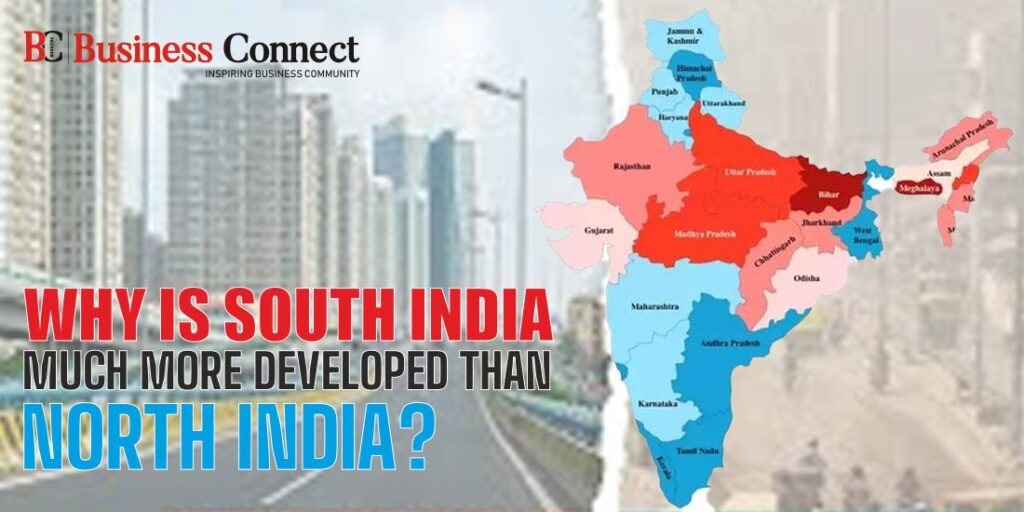Why is South India Much More Developed than North India? Exploring Key Factors and Socioeconomic Dynamics?
Hello business magazine readers, India is a country known for its rich cultural heritage and diversity, is often recognized for its regional disparities in development. While the northern and southern regions have their unique strengths, why is south india better than north India it is undeniable that South India has experienced higher levels of development compared to the northern counter part.
This article aims to delve into the various factors that have contributed to the differential development between south india vs north indian, shedding light on the historical, geographical, and socioeconomic aspects that have shaped these regions over time. today we talk about Why is South India much more developed than north india? Exploring Key Factors and Socioeconomic Dynamics?

Why is South India More Developed?
Historical Factors:
Historical context plays a crucial role in understanding the present-day developmental disparities between South & North India. The southern region of India witnessed the early establishment of powerful empires like Cholas, Cheras, & Pandyas, which fostered a strong foundation in terms of infrastructure, trade, & governance. the legacy of these kingdoms can still be seen in the well-preserved temples, intricate art, & robust urban planning in cities like Chennai and Madurai.
On the other hand, the northern region experienced frequent invasions & power struggles throughout history, leading to the destruction of existing structures & institutions. the mughal empire, while bringing significant cultural & architectural influences, also witnessed a decline in governance and administrative systems. this historical backdrop has had a lasting impact on the development trajectory of both regions.
a) Early Kingdoms & Trade Routes: South India has a rich historical legacy, with ancient kingdoms like the Cholas, Pandyas, & Cheras, fostering trade and commerce. these kingdoms developed extensive trade links with foreign nations, facilitating economic growth & cultural exchange. in contrast, North India experienced frequent invasions & political instability, hindering long term development.
b) Colonial Influence: British colonial rule had a profound impact on both regions. South India witnessed early contact with European powers, leading to the establishment of educational institutions, modern industries, & infrastructure. this exposure provided a head start for development. On the other hand, North India faced prolonged subjugation, resulting in limited opportunities for growth.
Geographic Factors:
Geographical factors also play a crucial role in the development disparities between North and South India. the southern region enjoys a favorable climate with abundant rainfall, fertile plains, and access to major rivers such as the Krishna, Godavari, & Kaveri. these geographical advantages have facilitated agricultural prosperity, allowing the region to become a significant contributor to India’s food production.
In contrast, the northern region faces diverse geographical challenges such as arid landscapes, limited water resources, & the Himalayan mountain range. these factors have posed challenges to agriculture, necessitating irrigation systems & water management practices. While advancements have been made, the geographical constraints have had an impact on the pace of development in the northern region.
Educational and Human Resource Development:
Education has been a driving force behind South India’s development. the region has a long-standing tradition of emphasizing education and literacy. states like Kerala and Tamil Nadu boast high literacy rates, well-established educational institutions, & a focus on quality education. this emphasis on education has created a skilled workforce, attracting investments and fostering innovation and entrepreneurship.
In comparison, the northern region has historically lagged behind in terms of educational indicators. Although efforts have been made to bridge the gap, challenges such as limited access to quality education & high dropout rates persist. the need for robust educational reforms remains a critical aspect in narrowing the developmental gap.
a) Higher Literacy Rates: South India has consistently maintained higher literacy rates than the North. Education plays a crucial role in socio-economic development, empowering individuals and fostering innovation. the emphasis on education in South India has created a skilled workforce, attracting investments and industries to the region.
b) Quality of Educational Institutions: South India boasts prestigious educational institutions like the Indian Institutes of Technology (IITs), Indian Institutes of Management (IIMs), & top-tier universities. these institutions have produced a pool of talented professionals who contribute significantly to the region’s development. In contrast, the north has fewer premier educational establishments, resulting in a talent drain to other regions.
Economic Factors:
Economic factors have also played a significant role in the developmental disparities. South India has witnessed robust economic growth, driven by sectors such as IT & software services, manufacturing, textiles & tourism. Cities like Bangalore, Chennai, Hyderabad have emerged as major economic hubs, attracting national and international investments.
northern region, while hosting important industrial centers like delhi & Noida, has faced challenges such as inadequate infrastructure, bureaucratic hurdles, & political instability, which have hindered its economic progress. however, it is important to note that the northern region has its own strengths, such as the agricultural sector the presence of important political institutions.
a) Industrialization & Manufacturing: South India has experienced significant industrialization, with sectors like information technology, automobile manufacturing, & textiles driving economic growth. the establishment of Special Economic Zones (SEZs) & technology parks has created a favorable environment for businesses & investments. In contrast, the north has lagged behind in industrial development, resulting in limited job opportunities.
b) Agriculture & Irrigation: While agriculture is a significant sector in both regions, South India has made substantial progress in irrigation infrastructure, leading to higher agricultural productivity. the Green Revolution, coupled with effective water management techniques, has propelled the region’s agricultural growth. In the north, inadequate irrigation facilities and dependence on monsoons have posed challenges to agricultural development.
Governance and Political Stability
Effective governance & political stability are essential for sustained development. South Indian states have often been commended for their efficient governance models, progressive policies,& long-term planning. the presence of stable political leadership has facilitated better implementation of developmental initiatives, ensuring the efficient utilization of resources.
a) State Governments: Effective governance and policy initiatives play a crucial role in shaping regional development. South Indian states have shown proactive governance, implementing progressive policies in education, healthcare, & industry. Moreover, these states have often been politically stable, enabling long-term planning & implementation of development strategies. the north, however, has faced governance issues, corruption, and frequent changes in political leadership, impeding progress.
b) Decentralization and Local Empowerment: South India has embraced decentralization & local empowerment, empowering communities to participate in decision-making processes. this bottom-up approach has fostered accountability, efficient resource allocation, & grassroots development. In contrast, the north has been slower in adopting decentralization, leading to a concentration of power and limited local involvement.
6. Infrastructure & Connectivity:
a) Port Facilities: South India benefits from a long coastline with well-developed ports such as Chennai, Kochi, and Visakhapatnam. These ports facilitate international trade and act as gateways for foreign investments, promoting economic growth. In comparison, the north has limited access to coastal regions, limiting its potential for maritime trade.
b) Transportation Networks: South India has a robust network of roads, railways, and airports, ensuring efficient connectivity within the region and beyond. this connectivity attracts businesses, facilitates tourism, & encourages the movement of goods and services. the north, in contrast, suffers from inadequate infrastructure, leading to logistical challenges and hampering development.
7. Agriculture and Irrigation:
While agriculture is a significant sector in both regions, South India has made substantial progress in irrigation infrastructure, leading to higher agricultural productivity. the Green Revolution, coupled with effective water management techniques, has propelled the region’s agricultural growth. In the north, inadequate irrigation facilities & dependence on monsoons have posed challenges to agricultural development.
In conclusion, several key factors and socioeconomic dynamics contribute to the development gap between South India and North India. Historical factors, education, infrastructure, economic factors, governance, and policy play significant roles in shaping the development trajectories of these regions.
Addressing the disparities and promoting equitable development require a comprehensive approach that focuses on strengthening education systems, improving infrastructure, encouraging industrial growth, fostering good governance practices in both regions. Only through concerted efforts can North India bridge the development gap & achieve sustainable progress.



